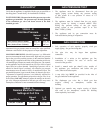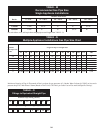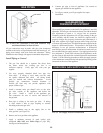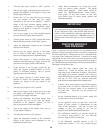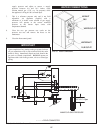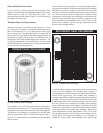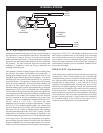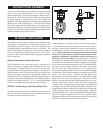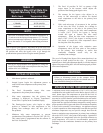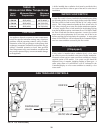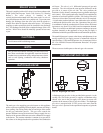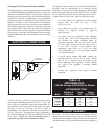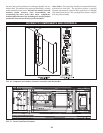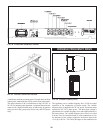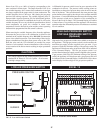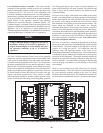
31
TABLE - P
Temperature Rise At Full Rate Fire
Bypass Manually Fully Closed
Btu/hr Input Temperature Rise
1,500,000
_______________________
1,700,000
_______________________
2,000,000
31.5°F (17.5°C)
_______________________
35.7°F (19.8°C)
_______________________
42.0°F (23.3°C)
NOTE:
The Excel 10 controller makes all internal calculations in
°C and converts the displayed temperature to °F. This may
limit exact temperature adjustment. Setting of temperature
rise to the nearest °F is acceptable when setting maximum
flow.
Turn off power to the appliance. Reconnect the power leads to the
bypass actuator. Turn power on and place the run/stop switch in the
run position and allow the bypass valve to go through the
synchronization process before it begins normal operation.
WARNINGƽ
Moving the bypass handle while appliance is firing can
result in abnormally high water temperature that may cause
sudden relief valve discharge.
BYPASS OPERATION
1. Main burner ignition is achieved.
2. Integral bypass begins the ad just ment process to
control inlet water temperature to the primary heat
exchanger.
3. The Excel 10-controller senses inlet water
temperature to the primary heat exchanger.
4. Inlet water temperature into the primary heat
exchanger is displayed as “Bypass Temperature”
in one of the 21 points on the Command Display.
5. The floating-point bypass valve begins to adjust
position to maintain an inlet temperature to the
primary heat exchanger above the dew point of
flue products.
6. Minimum inlet water temperature to prevent
condensation of flue products is fixed at 130°F (54.4°C).
This con trol point is programmed into the soft ware in
the Excel 10 controller.
7. The Excel 10 provides 24 VAC to operate a high
torque motor in the actuator, which adjusts the
position of the floating-point bypass valve.
8. The actuator for the bypass valve adjusts in as
many as 500 micro-steps to achieve the desired
water tem per a ture at the inlet to the primary heat
exchanger.
9. With each micro-step of movement in the position
of the valve, the Excel 10 checks for a change in
water tem per a ture at the inlet to the primary heat
exchanger. As long as the inlet water temperature
is below 130°F (54.4°C) the bypass is moving
toward full open to increase the inlet water
temperature. When the inlet water temperature is
above 130°F (54.4°C) the bypass is mov ing toward
full closed to sustain the water temperature above
the dewpoint of the flue products.
10. Operation of the bypass valve main tains water
temperatures above the dew point of flue products
at the primary heat exchanger to ensure that
condensate formation occurs only on the
secondary heat exchanger.
The use of a Floating-Point Bypass Valve means that there is no
fixed open or closed position on the valve. If errant hands
manually move the bypass adjustment handle, it will take longer to
adjust to the proper setting but it will still function properly to main -
tain water temperatures.
CAUTIONƽ
Failure to disconnect power to the actuator before
declutching or manually moving the valve handle can cause
non-warrantable damage to the actuator.
MINIMUM WATER TEMPERATURES
A minimum return water temperature of 50°F (10°C) has been
established for each model based on the Btu/hr output at 100% of
rated burner input. The temperature set point for the Excel 10
controller sensing system temperature or stored water temperature
must not be set lower than the specified minimum for each model.
Maintaining inlet water temperatures to the appliance equal to or
higher than the specified minimum temperature setting ensures
proper op er a tion of the bypass and allows all con den sate formation
to occur on the sec ond ary heat exchanger. An appliance allowed
to sustain operation at water temperatures lower than the specified
minimum temperature may not provide enough heat from the
burner to maintain water temperatures in primary heat exchanger
above the 130°F (54.4°C) dew point of flue prod ucts. Operation of
the appliance at a temperature below the specified minimum set
point temperature will result in non-warrantable operational
problems from the con den sate formation on the primary heat
exchanger.



